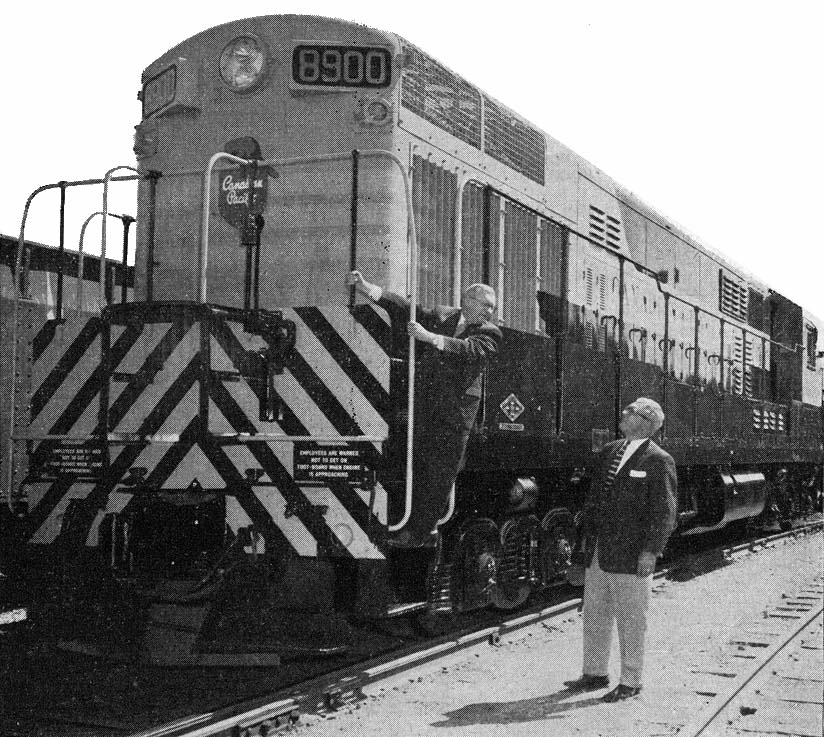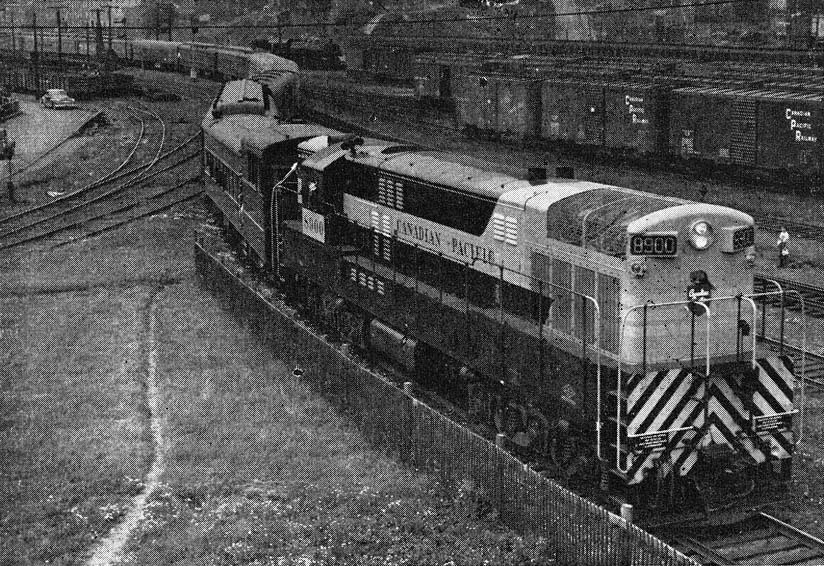
Most Powerful Diesel Unit in Canada

Presentation to the Canadian Pacific Railway of the most powerful diesel locomotive in Canada, described as "another Canadian Pacific
first" by D.S. Thomson, vice president with jurisdiction over all C.P.R. lines, was held at Kingston recently in the presence of top railway and
Canadian Locomotive Company officials.
The powerful new "Trainmaster" diesel locomotive, first unit of its kind in Canada, began its service on Canadian Pacific lines between Montreal and Saint John, New Brunswick, on 12 Jul 1955.
In accepting delivery of the powerful diesel, Vice President Thomson said the 2,400 horsepower unit would give "Canadian Pacific yet another first in Canada with what the builders assert is the finest."
"We propose to run this locomotive for a time, both in passenger and freight service, between Montreal and Saint John, after which it will be sent West to the Mountains, where a number of your locomotives are giving good service in that rugged territory."
"The territory on which it will finally find its niche will be dependent on where it will earn the best return on the investment," Mr. Thomson said.
The 2,400 horsepower diesel is scheduled to make several test runs in both passenger and freight service between Montreal and Saint John before heading for the Pacific Region to undergo even more rigorous tests on the Kettle Valley Division.
Attending the presentation ceremonies were B.W. Roberts, vice president purchases and stores, L.B. George, assistant chief of motive power and rolling stock, and W.F. Sinclair, engineer of motive power.
Features of the "Trainmaster" include a maximum speed of 75 miles per hour, more horsepower and pulling power (tractive effort) than any other diesel locomotive on Canadian Pacific lines, and controls which will permit the new diesel to work in multiple with units of other makes.

Above is elevation drawing of the Diesel Trainmaster. Following are some of the specifications and locomotive data on this powerful unit: AAR
wheelhase classification C-C, Power available tor traction 2,400 H.P., Power dissipated in dynamic braking 3,000 H.P., Fuel oil capacity 1,500 imperial
gallons, Lube oil capacity 320 imperial gallons, Engine cooling water capacity 210 imperial gallons, Steam generator water capacity 2,000 imperial
gallons, Sand capacity 48 cubic feet, Lenqth inside knuckles 66 feet 0 inches, Total wheel base 49 feet 4 inches, Truck wheel base 13 feet 0 inches,
Overall height above rail 15 feet 6 inches, Overall width 10 feet 4 1/2 inches, Loaded locomotive weight 388,000 pounds, Minimum radius of curvature
(one unit) 191 feet (30 degrees), Minimum radius of curvature coupled to AAR 40 foot freight car 212 feet (27 degrees), Gear ratio 65:78, Wheel diameter
40 feet, Maximum speed 75 m.p.h., Minimum continuous speed 10 m.p.h., Maximum continuous tractive 69,800 pounds.

 and is reprinted here with their permission.
All photographs, logos, and trademarks are the property of the Canadian Pacific Railway Company.
and is reprinted here with their permission.
All photographs, logos, and trademarks are the property of the Canadian Pacific Railway Company.